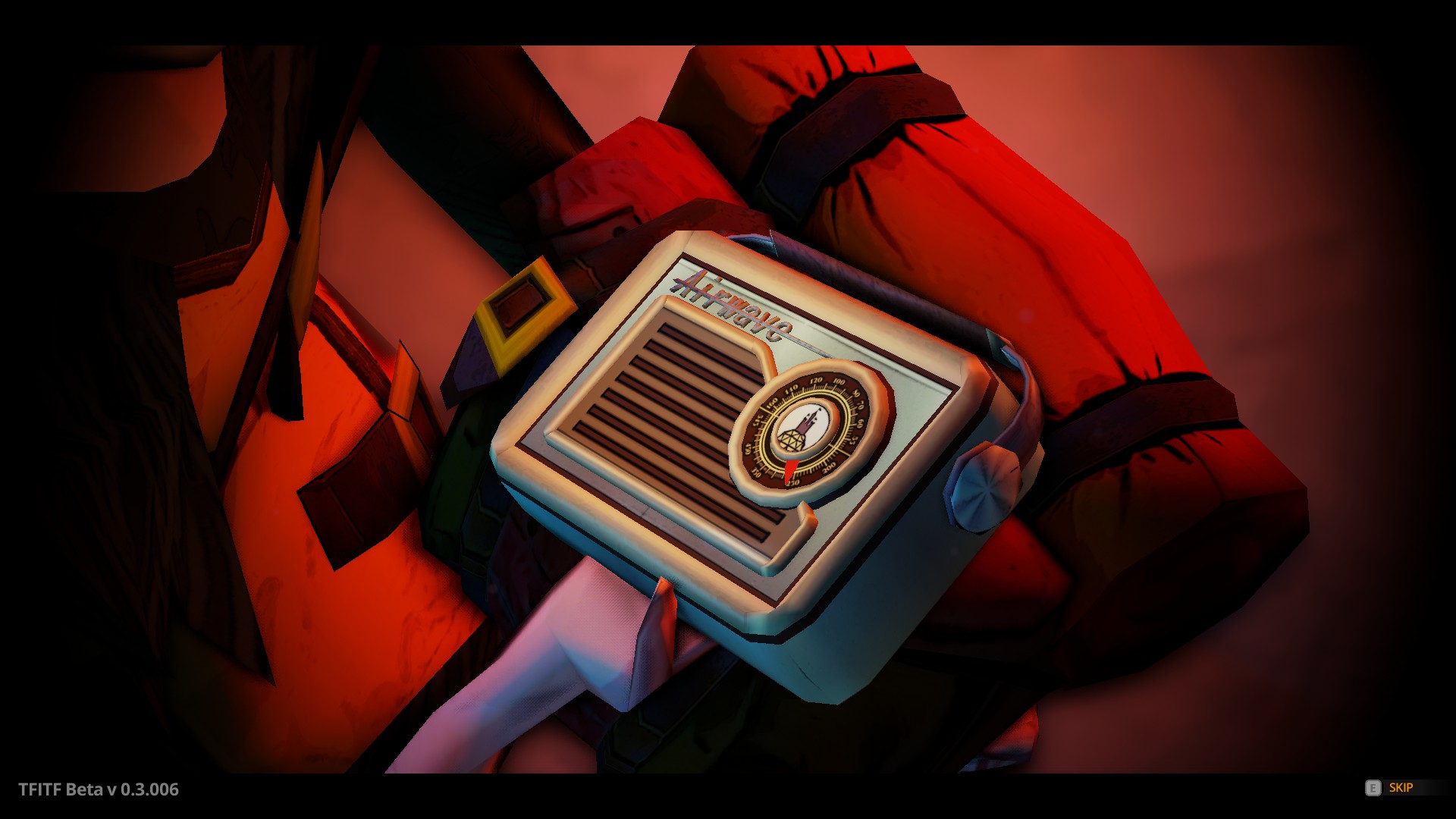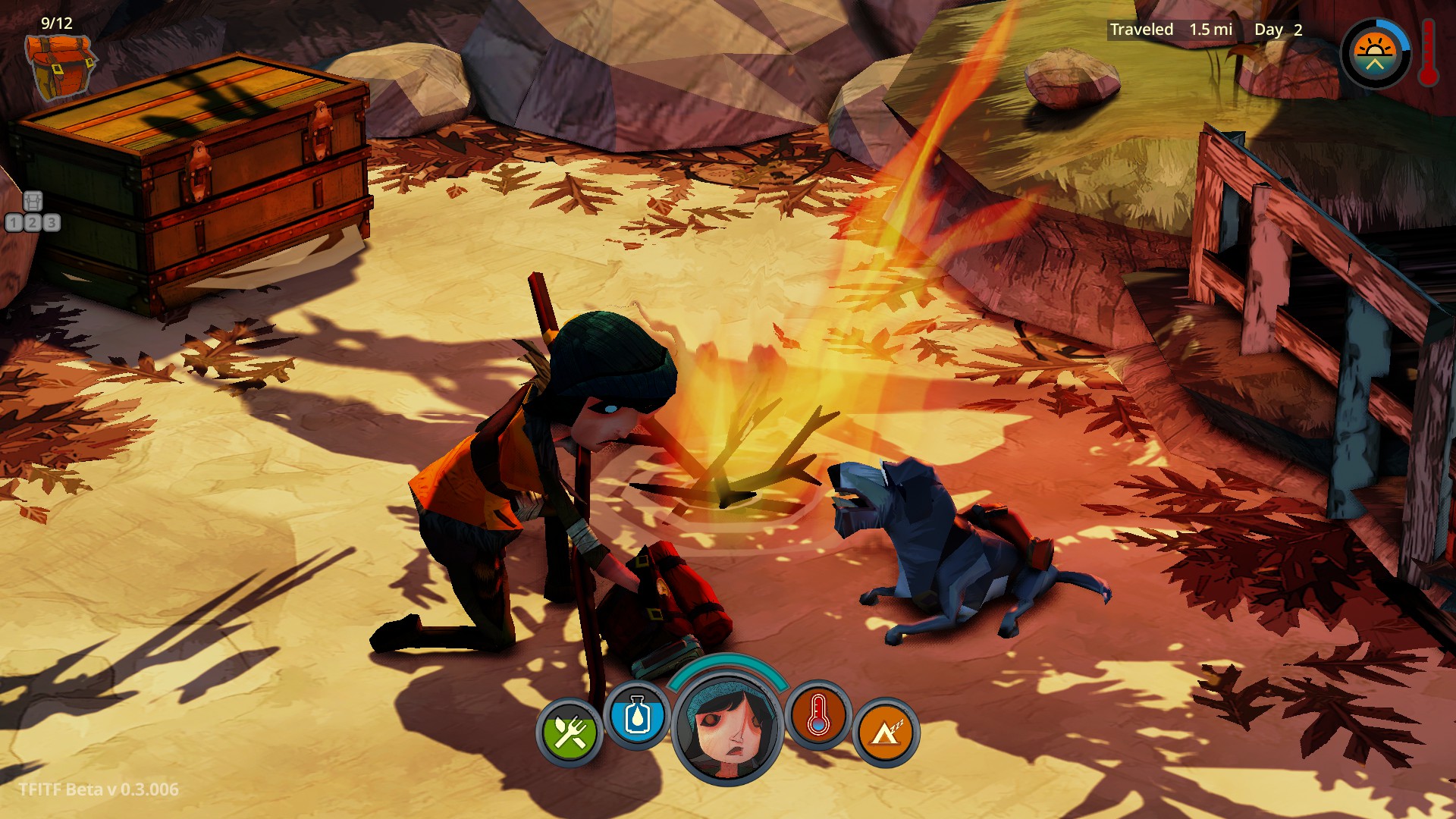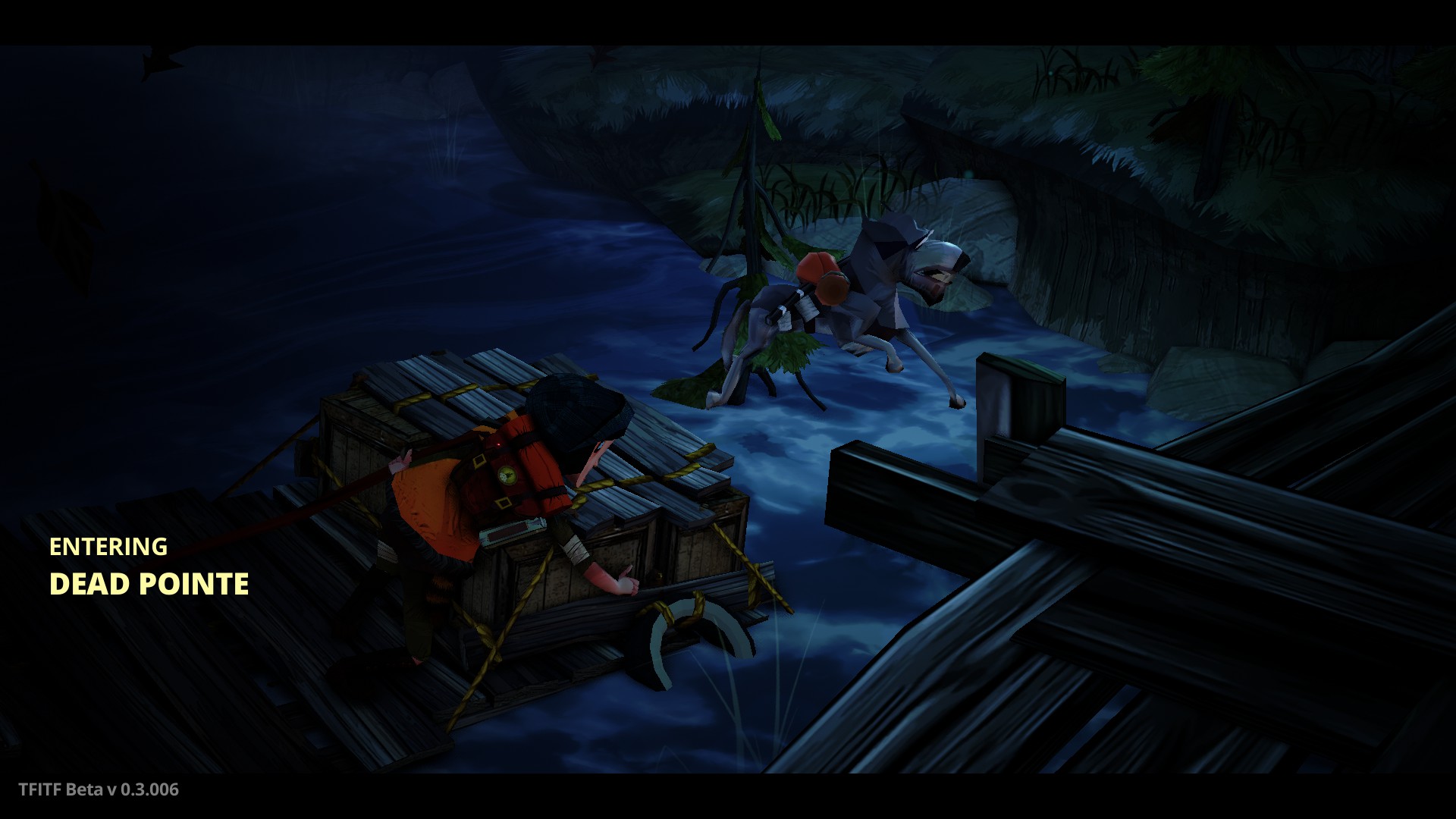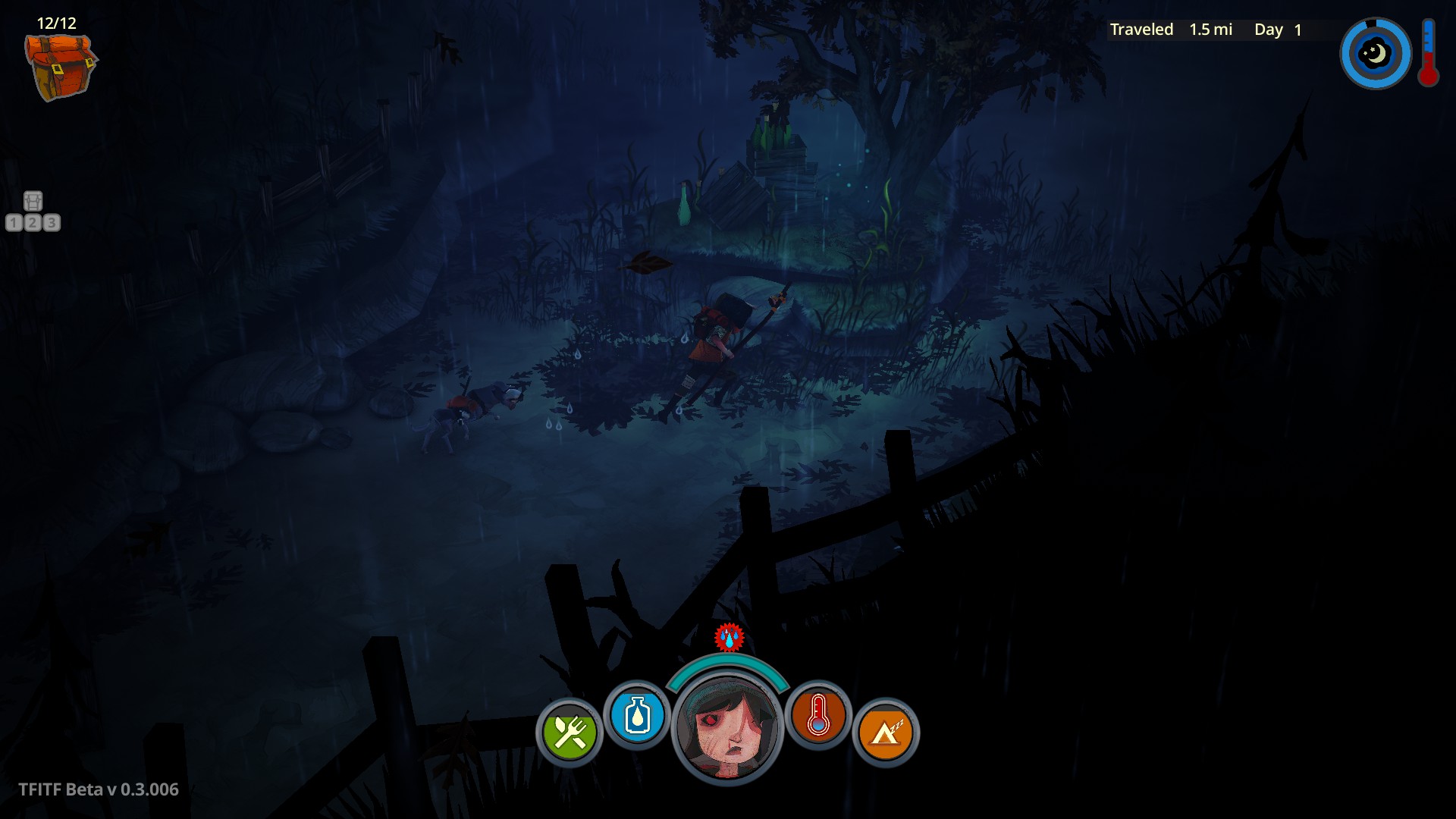After a successful Kickstarter funding their first IP as an indie studio The Molasses Flood, comprised of several AAA industry veterans, has released The Flame in the Flood on Steam Early Access. This roguelike survival game built on top of the Unreal 4 Engine runs smoothly on a set of easy-to-learn gameplay mechanics that seem a bit daunting upon first glance, however it’s not as difficult as one might expect upon jumping into it. I’m the kind of player who closes out tutorial dialogues before allowing myself enough time to read the whole thing, so even with skipping through the brief yet stylish tutorial hint pop-ups it only took about three to five minutes to get used to the controls and how to keep Scout from dying.
 The Flame in the Flood begins with Aesop the dog bringing Scout a bag that was resting next to a skeleton. Scout pulls a radio with a garbled signal out of the bag. Intercepting the signal is the first objective, however the campaign is locked as it’s not completed. Instead, the Early Access is played in a free mode, basically giving us the opportunity to practice staying alive. Braving wolves, taking shelter from a storm, and crafting food and supplies will take precedence.
The Flame in the Flood begins with Aesop the dog bringing Scout a bag that was resting next to a skeleton. Scout pulls a radio with a garbled signal out of the bag. Intercepting the signal is the first objective, however the campaign is locked as it’s not completed. Instead, the Early Access is played in a free mode, basically giving us the opportunity to practice staying alive. Braving wolves, taking shelter from a storm, and crafting food and supplies will take precedence.
I sit there looking at the screen wondering what to do first. There’s a shack, some interactive environment props, and a barking dog. Now is the time to figure out how to eat and drink. I find a tiny pond and fill my water jar with filthy water and use a water filter to purify the first drink. Land masses are miniature in scale, so it’s not long until I’m jumping in a raft to be whisked away down the ever-flowing river. Port side, there’s a house taking a swim before getting dragged beneath a small island in the center of the river. Looking starboard there’s a tree dangerously thrashing its way through the rapids, which I first thought was a dragon as I could only see the silhouette at first (I’m not the most alert person and my imagination takes over).
Avoiding a collision with a landmass, I spot a dock where I can tether the raft and search for supplies. There’s a place to make a fire, sleep in a shelter, and in the surrounding area there are plenty of plants to gather and junk to sort through. Crafting comes easily, unlocking recipes and thumbing through the crafting tab of the menu is a simplistic task accentuated by the user-friendly prompts that appear when the player has the proper ingredients to craft the respective item.
 I awaken after rest, taking note the dwindling hunger and thirst meter which sleep takes a chunk out of. It’s day and I may be naive, but my fear of being attacked by a wolf is lifted for now (this is before I knew about the hostile boars). I’m making quick work of each location I tie the raft to. Making tools and making sure my inventory (and Aesop’s) stays packed to max capacity keeps me busy enough until I suffer an injury from that evil wild boar. At this point I had not crafted traps, and the only thing Scout can do in defense besides dodging is wave her hands in the air in an attempt to scare off the beast. This may have worked earlier on the crows around my camp, but man did my world get flipped upside down when my idiotic arm waving did nothing but make me a sitting duck. One hit and I’m hurt bad, limping away from the pig with a grudge, trying to get it as far off-screen as possible to figure out a way to heal.
I awaken after rest, taking note the dwindling hunger and thirst meter which sleep takes a chunk out of. It’s day and I may be naive, but my fear of being attacked by a wolf is lifted for now (this is before I knew about the hostile boars). I’m making quick work of each location I tie the raft to. Making tools and making sure my inventory (and Aesop’s) stays packed to max capacity keeps me busy enough until I suffer an injury from that evil wild boar. At this point I had not crafted traps, and the only thing Scout can do in defense besides dodging is wave her hands in the air in an attempt to scare off the beast. This may have worked earlier on the crows around my camp, but man did my world get flipped upside down when my idiotic arm waving did nothing but make me a sitting duck. One hit and I’m hurt bad, limping away from the pig with a grudge, trying to get it as far off-screen as possible to figure out a way to heal.
I’ve reached a safe spot, and I’m digging through the pack to find that splint I crafted earlier. There’s actually an ailments tab in the inventory menu, and the player can see all current status effects and ailments. If the proper healing items are in the inventory, the cure button appears and a simple click will do the job. I don’t bother, and instead just use the splint directly from the inventory hoping that it would do something. It didn’t exactly cure me, but it seemed to be enough to get me back to the raft and out of that perilous, unforgiving dirt mound.
 Unbeknownst to me, my journey was coming to an end. Poor resource management combined with bad luck in finding necessities led to a fit of starvation and dehydration. Eventually all I could do was crawl along the ground while the heartless Aesop trotted along as if poor Scout wasn’t dying in front of his eyes. Eventually, I collapsed for good, and as the death screen dissolved I realized I forgot to eat the grubs and worms I had with me.
Unbeknownst to me, my journey was coming to an end. Poor resource management combined with bad luck in finding necessities led to a fit of starvation and dehydration. Eventually all I could do was crawl along the ground while the heartless Aesop trotted along as if poor Scout wasn’t dying in front of his eyes. Eventually, I collapsed for good, and as the death screen dissolved I realized I forgot to eat the grubs and worms I had with me.
I wasn’t disheartened though, and instead found that at this point I was beginning to feel the addiction set in. Determined to find my dead body, I breezed through the beginning like a veteran, wasting no time jumping back into the raft and careening down the river like mad. Not wise, as I collided with the land a couple times in my haste, busting up poor Scout’s low-poly face. Saddened by this sight I stopped at the next dock, patched her up, grabbed some food, and headed back down the river. The currents make it tough to land at a dock if it’s on the complete opposite side from you, and even slowing down and turning as hard as possible can result in a missed chance. The raft can’t be turned around, so it’s onto the next possible location, shrugging off the slight sense of defeat.
 With my adventure in a to-be-continued state, I pause to convey how I feel about The Flame in the Flood. After anxiously awaiting the emergence of a playable build, I’m not disappointed at all. There’s a lot to get into at this stage, and although a fair amount of the environment props are recycled through the world (causing some locations to look and feel similar), it’s easily dismissed once the addiction of scavenging and crafting sets in. Obviously this can be overlooked because as an Unreal Engine developer myself I understand how difficult it is to flood a new IP with enough unique art before Early Access, as most of the priority may have gone to programming and Blueprint scripting. The art style and atmosphere in The Flame in the Flood blend together well, despite the cute low-poly appearance one typically associates with a less melancholic mood. The sounds and music overlay the game world in a solid manner that drives gameplay without bumps or rest stops. The Flame in the Flood lives up to the expectations I had after becoming acquainted with the project, and The Molasses Flood made great use of Unreal Engine 4, providing a great experience with no bugs or glitches that I found in my first playthrough. The Flame in the Flood Early Access will leave you satisfied and looking forward to seeing it filled with more content and the much-anticipated campaign mode, check it out!
With my adventure in a to-be-continued state, I pause to convey how I feel about The Flame in the Flood. After anxiously awaiting the emergence of a playable build, I’m not disappointed at all. There’s a lot to get into at this stage, and although a fair amount of the environment props are recycled through the world (causing some locations to look and feel similar), it’s easily dismissed once the addiction of scavenging and crafting sets in. Obviously this can be overlooked because as an Unreal Engine developer myself I understand how difficult it is to flood a new IP with enough unique art before Early Access, as most of the priority may have gone to programming and Blueprint scripting. The art style and atmosphere in The Flame in the Flood blend together well, despite the cute low-poly appearance one typically associates with a less melancholic mood. The sounds and music overlay the game world in a solid manner that drives gameplay without bumps or rest stops. The Flame in the Flood lives up to the expectations I had after becoming acquainted with the project, and The Molasses Flood made great use of Unreal Engine 4, providing a great experience with no bugs or glitches that I found in my first playthrough. The Flame in the Flood Early Access will leave you satisfied and looking forward to seeing it filled with more content and the much-anticipated campaign mode, check it out!



